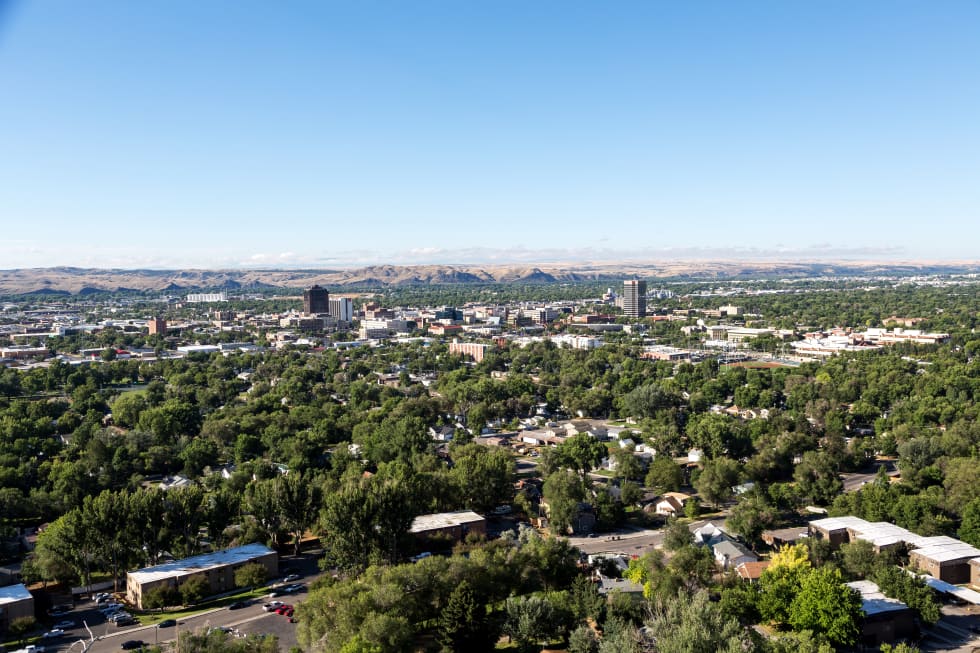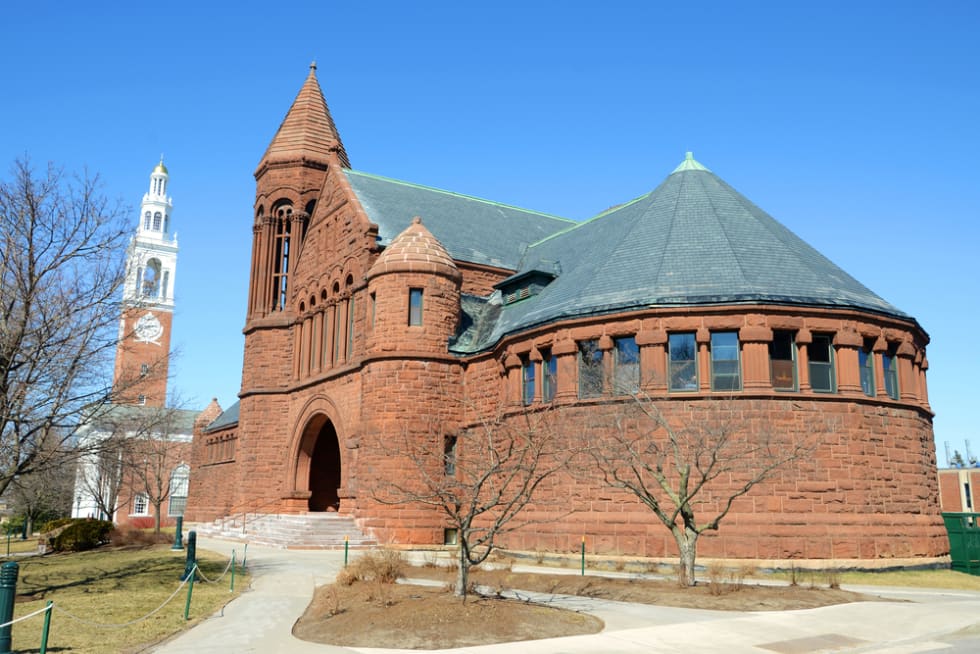Farmstead Townhomes
- 22 units available
- 3 bed
- Amenities
In unit laundry, Patio / balcony, Pet friendly, Parking, Gym, Pool + more

If you’re thinking about moving West and want to know the price tag, the cost of living in Billings, MT is 5.4% lower than the U.S. average.
Billings is considered one of the best places to live in Montana and its largest city. It’s also home to about 117,000 people. With a strong economy primarily made up of healthcare and trade, newcomers arrive looking for new careers and access to wide-open outdoor spaces. Billings blends affordability with opportunity.
Compared to a similar-sized city like Fort Collins, the average rents run $1,523 for a studio, $1,692 for a one-bedroom, and $1,864 for a two-bedroom. In Billings, those same units average $1,312, $1,391, and $1,449, giving renters a noticeable break on smaller apartments. Three-bedrooms are closer in price, with $2,394 in Billings versus $2,376 in Fort Collins.
Whether you’re considering a move for work, lifestyle, or family reasons, we broke down what everyday life will cost. From housing and groceries to utilities and transportation, here’s what to expect if you’re planning a future in Billings.

Billings has a cost of living index of 94.6, which is below both the Montana state average and the national figure. That means your paycheck stretches further here than in many other cities. While groceries come in slightly higher than the U.S. average, housing, healthcare, and transportation pull overall costs down.
On a monthly basis, a single adult living in Billings should budget around $2,867 for rent, food, utilities, transportation, and other essentials, or about $34,400 annually. A family of four will need closer to $5,910 per month, or about $70,920 annually, which is still more affordable than many western metros of similar size.
Here’s how Billings compares across categories:
| Cost of Living | Billings | Montana | U.S. |
|---|---|---|---|
| Overall | 94.6 | 100.0 | 100.0 |
| Grocery | 101.3 | 99.6 | 100.0 |
| Health | 93.3 | 99.6 | 100.0 |
| Housing | 97.9 | 121.3 | 100.0 |
| Median Home Cost | $369,900 | $441,800 | $338,100 |
| Utilities | 95.6 | 90.7 | 100.0 |
| Transportation | 75.2 | 75.2 | 100.0 |
| Miscellaneous | 112.7 | 90.0 | 100.0 |
Data from BestPlaces.
If you’re looking at the upper end of the rental market, North Central Billings is one of the most expensive neighborhoods. The average rent here reaches $1,699 for a one-bedroom apartment, which is higher than the citywide average.
These higher rents often come with newer construction and more amenities: think updated kitchens, in-unit laundry, and fitness centers on-site. Living closer to downtown Billings also means faster access to shopping, restaurants, and cultural activities, though you’ll pay a premium for that convenience. For renters prioritizing location and upgraded spaces, North Central is a clear option.
On the other side of the spectrum, Billings Heights stands out as an ideal option for budget renters looking for affordability. The average rent for a one-bedroom is about $1,376, nearly $330 less than the North Central area. That savings adds up quickly to more than $3,900 annually compared to higher-end areas.
Billings Heights offers a balance between price and livability. Lower rents mean more flexibility in a household budget, though it’s worth weighing factors like commute times, neighborhood amenities, and school options before signing a lease.
As of September 2025, the average rent across all unit types in Billings is $1,636.50. That’s nearly $466 less than the U.S. average of $2,102, giving renters in Billings a noticeable advantage.
Compared to many western cities like Denver, where average rents climb to $2,049, Billings rents have remained stable, avoiding the sharp fluctuations and spikes seen elsewhere. The predictability makes it easier for renters to plan long-term, whether they’re budgeting for savings, childcare, or other expenses.
| Unit Type | Average Rent |
|---|---|
| Studio | $1,312 |
| 1-Bedroom | $1,391 |
| 2-Bedroom | $1,449 |
| 3-Bedroom | $2,394 |
Buying a home in Billings is still relatively affordable, especially compared to areas like Denver, where the median house costs $576,000. The median home price in Billings is just $369,900, which is below Montana’s statewide median of $441,800. It’s slightly higher than the national average of $338,100, but remains within reach for many buyers.
For households not ready to commit, renting continues to be an attractive option. With steady rent levels and fewer upfront costs, apartment living provides flexibility while keeping housing expenses predictable.
We recommend keeping your housing costs in line with the 30% rule, which stipulates spending no more than 30% of your gross income on rent. That means you’ll need to earn at least $60,200 annually if you’re renting at the city average of $1,505. That translates to about $5,017 per month, or $28.94 per hour.
You can also take a look at the living wage in Billings, or the minimum amount you need to cover expenses like food, shelter, and rent. According to MIT’s living wage data, a single adult with no children needs $22.12 per hour, $3,834.17 per month, or about $46,010 per year to cover just the essentials in Billings. You’ll need to bring up your income if you want to travel, build an emergency fund, or need to pay off student loans.
The living wage data and 30% rule breakdown are actually less than what the U.S. Census reports as the median household income in Billings of $69,112. That’s good news for renters who will likely meet or exceed what’s required for affordability.
Transportation is another area where Billings beats national averages. While most residents rely on cars, the costs are lower than in many cities. Single adults spend $10,602 per year on transportation, while a family of four with two working adults will spend around $17,784 each year.
Gasoline averages $3.05 per gallon, and if you rely on public transportation, local bus fares run $2.00 per ride or $28.00 for a monthly pass. Taxi services start at $2.50, with about $2.20 per mile added.
With limited public transit coverage, owning a car is the norm. Choosing to rent closer to work or shopping areas can cut down on mileage and make transportation even more affordable.
Groceries in Billings sit slightly above national averages, with higher prices for proteins and dairy. According to MIT's data, a single adult with no children will spend about $4,131 a year on food. A family of four with two working adults and two children will spend around $12,108 per year.
Households can expect staples like milk and bread to be reasonably priced, but meat often costs more.
Here are some common prices:
Dining out remains affordable by national standards. A three-course meal for two runs about $75, while a quick bite at an inexpensive restaurant averages $26 per person. That makes it easy to balance home cooking with meals without breaking the budget.
Childcare costs in Billings are significant at $13,531 for just one child and $25,089 for two children. Those figures put families with multiple children in a challenging spot, as expenses can quickly double or triple.
Costs also vary by neighborhood and availability. Central neighborhoods with fewer childcare openings may charge higher rates, while suburban areas with more providers may be somewhat cheaper. Many families rely on creative solutions, like alternating work schedules or leaning on relatives for support, to manage expenses.
Healthcare costs in Billings come in below the U.S. average, which helps lower the city’s overall affordability profile. A single adult spends about $2,777 annually, while a family of three pays closer to $7,920 per year.
Access to hospitals and medical providers is also solid, with major providers like Billings Clinic and St. Vincent Healthcare offering a wide range of services. The combination of affordability and availability makes healthcare less of a strain than in larger metros, where costs run higher.
Utilities in Billings are moderate compared to national averages. For a 915-square-foot apartment, renters can expect to pay about $148.13 per month for basics like electricity, heating, cooling, water, and garbage. Adding internet ($86.33) and cell service ($49.20) brings the total to roughly $283.66 per month.
Montana’s winter weather can push bills higher, but the overall yearly average keeps utilities manageable. For renters budgeting carefully, this predictability makes Billings a stable choice compared to metros where utilities fluctuate more wildly.
Billings makes it easy to stay active without overspending. Many residents take advantage of the Rimrocks, Yellowstone River, and nearby trails for free recreation. At the same time, indoor fitness and entertainment options are priced affordably.
To stay fit at the gym, locals can expect to pay an average of $48.33 per month. For a night out at the movies, tickets run about $14 per ticket, not including snacks and a drink. Community centers and local leagues provide additional options for staying active at little cost. With this mix of outdoor and indoor opportunities, entertainment in Billings is accessible on almost any budget.
Montana is unique in that it has no statewide sales tax, saving residents hundreds of dollars each year on everyday purchases. Income tax rates are progressive, ranging from 4.7% to 5.9%, which is moderate compared to other states. Property taxes are also relatively low, keeping homeownership costs stable.
For residents, the combination of no sales tax and reasonable property taxes makes Billings a tax-friendly place to settle.

Billings is the hub of Montana’s economic center, with strong opportunities in healthcare, energy, trade, and education. Healthcare practitioners average $101,660 annually, while business and financial professionals earn about $76,690, and construction roles come in around $59,030 per year.
Billings offers renters an appealing mix of affordability and access to Montana’s outdoors. With average rents at $1,505 and cost of living below the U.S. average, it’s a practical choice for anyone looking to make their paycheck go further.
When you’re ready to begin your apartment search, take our quiz to save yourself 50 hours of searching to find rentals in Billings that match your income, needs, and lifestyle.
Yes. Billings is 5.4% cheaper than the national average, with lower costs in housing, healthcare, and transportation (BestPlaces). Compared to Fort Collins, CO—a similar-sized city—Billings rents are more than $500 less per month.
Renters need around $60,200 annually to afford the average apartment at $1,505. MIT’s Living Wage Calculator suggests a single adult needs $22.12/hour, while a family of four with two working adults should earn about $15.46/hour each (MIT Living Wage).
No. Utilities average $148 monthly for a standard apartment. Adding internet and mobile service brings the total to about $284, which is moderate compared to U.S. averages (Numbeo).
Childcare averages $1,086 per month per child, or more than $13,000 annually (Numbeo). Families with multiple children should expect significantly higher yearly expenses.
North Central Billings is among the priciest, with average one-bedroom rents at $1,699. Renters here often pay more for newer apartments and upgraded amenities.
Billings Heights offers some of the city’s lowest rents, with one-bedroom apartments averaging $1,376 per month. This area is popular among budget-conscious renters.
Billings is far more budget-friendly. While Fort Collins rents average $2,031, Billings comes in at $1,505 each month. That difference saves renters more than $6,000 annually.



In unit laundry, Patio / balcony, Pet friendly, Parking, Gym, Pool + more
In unit laundry, Patio / balcony, Granite counters, Hardwood floors, Dishwasher, Dogs allowed + more